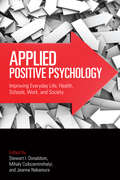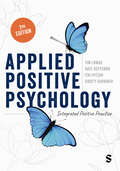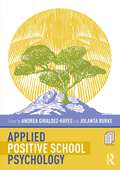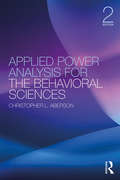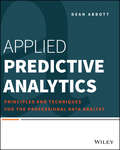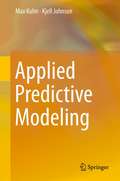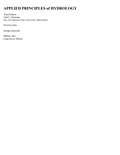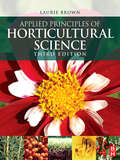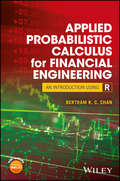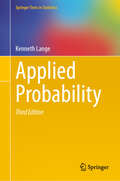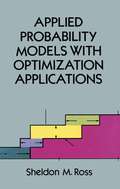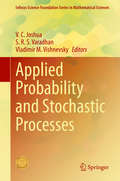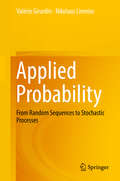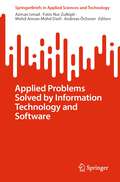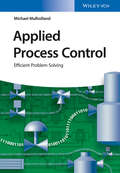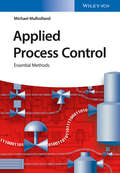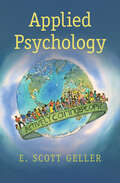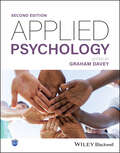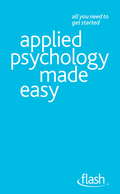- Table View
- List View
Applied Positive Psychology: Improving Everyday Life, Health, Schools, Work, and Society (Applied Psychology Series)
by Mihaly Csikszentmihalyi Stewart I. Donaldson Jeanne NakamuraPositive Psychology has experienced extraordinary growth over the past decade. Emerging research in this area is suggesting new strategies for improving everyday life, healthcare, education systems, organizations and work life, and societies across the globe. This book will be of interest to all applied psychologists, applied researchers, social and organizational psychologists, and anyone interested in applying the science of positive psychology to improvement of the human condition.
Applied Positive Psychology: Integrated Positive Practice
by Dr Tim Lomas Itai Ivtzan Kate HefferonInstructors - Electronic inspection copies are available or contact your local sales representative for an inspection copy of the print version. “If you think you know what positive psychology is, think again! This book offers a new integrative vision for making life better that takes in the body and the brain, culture and society, childhood and development... A must read for students.” - Stephen Joseph, University of Nottingham "Captures the best of the positive psychology initiative, and most importantly, translates it to practice. The authors bring remarkable depth and breadth to the subject matter and do so in a way that is fresh, engaging, relevant, and unusually thoughtful." - Carol Ryff, University of Wisconsin-Madison "If you want to understand what positive psychology really is, learn how it works in practice and discover its huge potential to transform our lives and our world then look no further than this superb book. I really can't recommend it highly enough." - Mark Williamson, Director of Action for Happiness This exciting new textbook, written by leading academics in the UK, offers the very first authored title on applied positive psychology for university courses. Consisting of the latest cutting-edge theory and research in the subject and structured around a pioneering multidimensional model of wellbeing, this book will provide you with the knowledge and tools to apply positive psychology in many areas of life. These include interventions aimed at developing mental and physical functioning, to recommendations for enhancing relationships and reshaping organisational structures. The book shows how these practices can be successfully deployed in diverse real-world settings, from the classroom to the workplace. Key features include: Learning objectives set out at the start of each chapter Practice essay questions throughout and quizzes to test your knowledge at the end of each chapter Useful measurement tools and recommendations for research Summary boxes and suggested further reading and resources Case studies and ‘Reflection’ boxes that invite you to explore topics in greater depth and relate findings to your everyday life. This book will be essential reading for all students with an interest in or studying a course in applied positive psychology, and is strongly recommended to students taking a wider course in positive psychology and the psychology of happiness and wellbeing.
Applied Positive Psychology: Integrated Positive Practice
by Dr Tim Lomas Itai Ivtzan Kate Hefferon"If you think you know what positive psychology is, think again! This book offers a new integrative vision for making life better that takes in the body and the brain, culture and society, childhood and development... A must read for students." - Stephen Joseph, University of Nottingham "Captures the best of the positive psychology initiative, and most importantly, translates it to practice. The authors bring remarkable depth and breadth to the subject matter and do so in a way that is fresh, engaging, relevant, and unusually thoughtful." - Carol Ryff, University of Wisconsin-Madison "If you want to understand what positive psychology really is, learn how it works in practice and discover its huge potential to transform our lives and our world then look no further than this superb book. I really can't recommend it highly enough." - Mark Williamson, Director of Action for Happiness "Does a brilliant job of showing readers how to apply the insights that research has uncovered. It will surely become one of the go-to text books for all students of positive psychology." - Nic Marks, creator of the Happy Planet Index, Five Ways to Wellbeing and Founder of Happiness Works This exciting new textbook, written by leading academics in the UK, offers the very first authored title on applied positive psychology for university courses. Consisting of the latest cutting-edge theory and research in the subject and structured around a pioneering multidimensional model of wellbeing, this book will provide you with the knowledge and tools to apply positive psychology in many areas of life. These include interventions aimed at developing mental and physical functioning, to recommendations for enhancing relationships and reshaping organisational structures. The book shows how these practices can be successfully deployed in diverse real-world settings, from the classroom to the workplace. Key features include: Learning objectives set out at the start of each chapter Practice essay questions throughout and quizzes to test your knowledge at the end of each chapter Useful measurement tools and recommendations for research Summary boxes and suggested further reading and resources Case studies and 'Reflection' boxes that invite you to explore topics in greater depth and relate findings to your everyday life. This book will be essential reading for all students with an interest in or studying a course in applied positive psychology, and is strongly recommended to students taking a wider course in positive psychology and the psychology of happiness and wellbeing.
Applied Positive Psychology: Integrated Positive Practice
by Itai Ivtzan Kate Hefferon Tim Lomas Kirsty GardinerUpdated with the latest theory and research and structured around a pioneering multidimensional model of wellbeing, this book equips you with the knowledge and tools to apply positive psychology to many areas of life. This includes interventions aimed at developing mental and physical functioning, as well as recommendations for enhancing relationships and reshaping organisational structures. A wealth of case studies show you how these practices can be successfully deployed in diverse real-world contexts, such as society, religion, the classroom and the workplace. Key features include: Learning objectives Practice essay questions and quizzes Useful psychometric tools you can adapt for your own research Summary boxes Case study and reflection boxes Suggested further reading Keyword definitions and glossary list of acronyms This book is essential reading for students of Applied Positive Psychology or the Psychology of Happiness and Wellbeing. Tim Lomas is a Psychology Research Scientist in the Department of Epidemiology at the Harvard T.H. Chan School of Public Health, and part of the Human Flourishing Program at Harvard University. Kate Hefferon has studied, lectured and worked in the areas of wellbeing and trauma research for 20 years. Itai Ivtzan is the Director of the School of Positive Transformation. Kirsty Gardiner is a Chartered Social Psychologist and a Research Director of a DEI consultancy.
Applied Positive Psychology: Integrated Positive Practice
by Itai Ivtzan Kate Hefferon Tim Lomas Kirsty GardinerUpdated with the latest theory and research and structured around a pioneering multidimensional model of wellbeing, this book equips you with the knowledge and tools to apply positive psychology to many areas of life. This includes interventions aimed at developing mental and physical functioning, as well as recommendations for enhancing relationships and reshaping organisational structures. A wealth of case studies show you how these practices can be successfully deployed in diverse real-world contexts, such as society, religion, the classroom and the workplace. Key features include: Learning objectives Practice essay questions and quizzes Useful psychometric tools you can adapt for your own research Summary boxes Case study and reflection boxes Suggested further reading Keyword definitions and glossary list of acronyms This book is essential reading for students of Applied Positive Psychology or the Psychology of Happiness and Wellbeing. Tim Lomas is a Psychology Research Scientist in the Department of Epidemiology at the Harvard T.H. Chan School of Public Health, and part of the Human Flourishing Program at Harvard University. Kate Hefferon has studied, lectured and worked in the areas of wellbeing and trauma research for 20 years. Itai Ivtzan is the Director of the School of Positive Transformation. Kirsty Gardiner is a Chartered Social Psychologist and a Research Director of a DEI consultancy.
Applied Positive School Psychology
by Andrea Giraldez-HayesApplied Positive School Psychology is an essential guide to help teachers regain their own and assist the school community in rebuilding their health post-pandemic. While research in positive psychology is thriving, teachers and educational practitioners find it challenging to apply it in their daily practice. This practical book fills the gap between theory and practice and provides practitioners with an evidence-based toolkit on using the positive psychology in their school communities. With contributions from experts in their field, this important resource explores student wellbeing, teacher wellbeing, inclusion, developing positive relationships, creativity, and therapeutic art. Written with the practitioner in mind, Applied Positive School Psychology is a must read for the teaching community and those interested in positive education. It will also be of interest to academics specialising in wellbeing or education, educational psychologists, and education policy makers.
Applied Power Analysis for the Behavioral Sciences: 2nd Edition
by Christopher L. AbersonApplied Power Analysis for the Behavioral Sciences is a practical "how-to" guide to conducting statistical power analyses for psychology and related fields. The book provides a guide to conducting analyses that is appropriate for researchers and students, including those with limited quantitative backgrounds. With practical use in mind, the text provides detailed coverage of topics such as how to estimate expected effect sizes and power analyses for complex designs. The topical coverage of the text, an applied approach, in-depth coverage of popular statistical procedures, and a focus on conducting analyses using R make the text a unique contribution to the power literature. To facilitate application and usability, the text includes ready-to-use R code developed for the text. An accompanying R package called pwr2ppl (available at https://github.com/chrisaberson/pwr2ppl) provides tools for conducting power analyses across each topic covered in the text.
Applied Predictive Analytics
by Dean AbbottLearn the art and science of predictive analytics -- techniques that get resultsPredictive analytics is what translates big data into meaningful, usable business information. Written by a leading expert in the field, this guide examines the science of the underlying algorithms as well as the principles and best practices that govern the art of predictive analytics. It clearly explains the theory behind predictive analytics, teaches the methods, principles, and techniques for conducting predictive analytics projects, and offers tips and tricks that are essential for successful predictive modeling. Hands-on examples and case studies are included.The ability to successfully apply predictive analytics enables businesses to effectively interpret big data; essential for competition todayThis guide teaches not only the principles of predictive analytics, but also how to apply them to achieve real, pragmatic solutionsExplains methods, principles, and techniques for conducting predictive analytics projects from start to finishIllustrates each technique with hands-on examples and includes as series of in-depth case studies that apply predictive analytics to common business scenariosA companion website provides all the data sets used to generate the examples as well as a free trial version of softwareApplied Predictive Analytics arms data and business analysts and business managers with the tools they need to interpret and capitalize on big data.
Applied Predictive Modeling
by Max Kuhn Kjell JohnsonThis text is intended for a broad audience as both an introduction to predictive models as well as a guide to applying them. Non-mathematical readers will appreciate the intuitive explanations of the techniques while an emphasis on problem-solving with real data across a wide variety of applications will aid practitioners who wish to extend their expertise. Readers should have knowledge of basic statistical ideas, such as correlation and linear regression analysis. While the text is biased against complex equations, a mathematical background is needed for advanced topics. Dr. Kuhn is a Director of Non-Clinical Statistics at Pfizer Global R&D in Groton Connecticut. He has been applying predictive models in the pharmaceutical and diagnostic industries for over 15 years and is the author of a number of R packages. Dr. Johnson has more than a decade of statistical consulting and predictive modeling experience in pharmaceutical research and development. He is a co-founder of Arbor Analytics, a firm specializing in predictive modeling and is a former Director of Statistics at Pfizer Global R&D. His scholarly work centers on the application and development of statistical methodology and learning algorithms.
Applied Principles Of Hydrology
by John C. ManningLess than 1% of the Earth's water is available for human use, the average family uses 400 gallons of water daily, and expected population growth means an increase in water use. The study of hydrology how water behaves as it moves through the water cycle is vital to reducing strains on our water supply and infrastructure.
Applied Principles of Horticultural Science
by Laurie BrownApplied Principles of Horticultural Science is that critical thing for all students of horticulture - a book that teaches the theory of horticultural science through the practice of horticulture itelf.The book is divided into three sections - Plant science, Soil science, Pest and disease. Each section contains a number of chapters relating to a major principle of applied horticulture. Each chapter starts with a key point summary and introduces the underpinning knowledge which is then reinforced by exercises. The book contains over 70 practical exercises, presented in a way that makes students think for themselves. Answers to the exercises are given at the end of chapters. Clear step-by-step instructions make practical work accessible to students of all abilities.This new third edition provides an even wider sweep of case studies to make this book an essential practical workbook for horticulture students and gardners alike. Updated material fits with the latest RHS, City and Guilds and Edexcel syllabus. It is particularly suitable for the RHS Certificate, Advanced Certificate and Edexcel Diplomas as well as for those undertaking NPTC National, Advanced National courses and Horticulture NVQs at levels 2 and 3, together with the new Diploma in Environmental and Land-based studies.Laurie Brown is a horticultural scientist and educator. He is Director of Academex, a consultancy company aspiring to excellence in teaching and learning. Laurie previously worked with the Standards Unit on the design of exemplary teaching resources in the land-based sector.
Applied Probabilistic Calculus for Financial Engineering: An Introduction Using R
by Bertram K. ChanIllustrates how R may be used successfully to solve problems in quantitative finance Applied Probabilistic Calculus for Financial Engineering: An Introduction Using R provides R recipes for asset allocation and portfolio optimization problems. It begins by introducing all the necessary probabilistic and statistical foundations, before moving on to topics related to asset allocation and portfolio optimization with R codes illustrated for various examples. This clear and concise book covers financial engineering, using R in data analysis, and univariate, bivariate, and multivariate data analysis. It examines probabilistic calculus for modeling financial engineering—walking the reader through building an effective financial model from the Geometric Brownian Motion (GBM) Model via probabilistic calculus, while also covering Ito Calculus. Classical mathematical models in financial engineering and modern portfolio theory are discussed—along with the Two Mutual Fund Theorem and The Sharpe Ratio. The book also looks at R as a calculator and using R in data analysis in financial engineering. Additionally, it covers asset allocation using R, financial risk modeling and portfolio optimization using R, global and local optimal values, locating functional maxima and minima, and portfolio optimization by performance analytics in CRAN. • Covers optimization methodologies in probabilistic calculus for financial engineering • Answers the question: What does a "Random Walk" Financial Theory look like? • Covers the GBM Model and the Random Walk Model • Examines modern theories of portfolio optimization, including The Markowitz Model of Modern Portfolio Theory (MPT), The Black-Litterman Model, and The Black-Scholes Option Pricing Model Applied Probabilistic Calculus for Financial Engineering: An Introduction Using R is an ideal reference for professionals and students in economics, econometrics, and finance, as well as for financial investment quants and financial engineers. BERTRAM K. C. CHAN, PhD, is Consulting Biostatistician at the Loma Linda University Health, School of Medicine, Loma Linda, CA. Dr. Chan is also Software Development and Forum Lecturer at the School of Public Health, LLUH Department of Biostatistics and Epidemiology.
Applied Probability (Springer Texts in Statistics)
by Kenneth LangeApplied Probability presents a unique blend of theory and applications, with special emphasis on mathematical modeling, computational techniques, and examples from the biological sciences. Chapter 1 reviews elementary probability and provides a brief survey of relevant results from measure theory. Chapter 2 is an extended essay on calculating expectations. Chapter 3 deals with probabilistic applications of convexity, inequalities, and optimization theory. Chapters 4 and 5 touch on combinatorics and combinatorial optimization. Chapters 6 through 11 present core material on stochastic processes. If supplemented with appropriate sections from Chapters 1 and 2, there is sufficient material for a traditional semester-long course in stochastic processes covering the basics of Poisson processes, Markov chains, branching processes, martingales, and diffusion processes. This third edition includes new topics and many worked exercises. The new chapter on entropy stresses Shannon entropy and its mathematical applications. New sections in existing chapters explain the Chinese restaurant problem, the infinite alleles model, saddlepoint approximations, and recurrence relations. The extensive list of new problems pursues topics such as random graph theory omitted in the previous editions. Computational probability receives even greater emphasis than earlier. Some of the solved problems are coding exercises, and Julia code is provided. Mathematical scientists from a variety of backgrounds will find Applied Probability appealing as a reference. This updated edition can serve as a textbook for graduate students in applied mathematics, biostatistics, computational biology, computer science, physics, and statistics. Readers should have a working knowledge of multivariate calculus, linear algebra, ordinary differential equations, and elementary probability theory.
Applied Probability Models with Optimization Applications
by Sheldon M. Ross"A clarity of style and a conciseness of treatment which students will find most welcome. The material is valuable and well organized ... an excellent introduction to applied probability." -- Journal of the American Statistical Association. This book offers a concise introduction to some of the stochastic processes that frequently arise in applied probability. Emphasis is on optimization models and methods, particularly in the area of decision processes. After reviewing some basic notions of probability theory and stochastic processes, the author presents a useful treatment of the Poisson process, including compound and nonhomogeneous Poisson processes. Subsequent chapters deal with such topics as renewal theory and Markov chains; semi-Markov, Markov renewal, and regenerative processes; inventory theory; and Brownian motion and continuous time optimization models.Each chapter is followed by a section of useful problems that illustrate and complement the text. There is also a short list of relevant references at the end of every chapter. Students will find this a largely self-contained text that requires little previous knowledge of the subject. It is especially suited for a one-year course in applied probability at the advanced undergraduate or beginning postgraduate level. 1970 edition.
Applied Probability and Stochastic Processes
by Frank BeicheltApplied Probability and Stochastic Processes, Second Edition presents a self-contained introduction to elementary probability theory and stochastic processes with a special emphasis on their applications in science, engineering, finance, computer science, and operations research. It covers the theoretical foundations for modeling time-dependent random phenomena in these areas and illustrates applications through the analysis of numerous practical examples. The author draws on his 50 years of experience in the field to give your students a better understanding of probability theory and stochastic processes and enable them to use stochastic modeling in their work. New to the Second Edition Completely rewritten part on probability theory—now more than double in size New sections on time series analysis, random walks, branching processes, and spectral analysis of stationary stochastic processes Comprehensive numerical discussions of examples, which replace the more theoretically challenging sections Additional examples, exercises, and figures Presenting the material in a student-friendly, application-oriented manner, this non-measure theoretic text only assumes a mathematical maturity that applied science students acquire during their undergraduate studies in mathematics. Many exercises allow students to assess their understanding of the topics. In addition, the book occasionally describes connections between probabilistic concepts and corresponding statistical approaches to facilitate comprehension. Some important proofs and challenging examples and exercises are also included for more theoretically interested readers.
Applied Probability and Stochastic Processes (Infosys Science Foundation Series)
by Vladimir M. Vishnevsky V. C. Joshua S. R. S. VaradhanThis book gathers selected papers presented at the International Conference on Advances in Applied Probability and Stochastic Processes, held at CMS College, Kerala, India, on 7–10 January 2019. It showcases high-quality research conducted in the field of applied probability and stochastic processes by focusing on techniques for the modelling and analysis of systems evolving with time. Further, it discusses the applications of stochastic modelling in queuing theory, reliability, inventory, financial mathematics, operations research, and more. This book is intended for a broad audience, ranging from researchers interested in applied probability, stochastic modelling with reference to queuing theory, inventory, and reliability, to those working in industries such as communication and computer networks, distributed information systems, next-generation communication systems, intelligent transportation networks, and financial markets.
Applied Probability: From Random Sequences To Stochastic Processes
by Nikolaos Limnios Valérie GirardinThis textbook addresses postgraduate students in applied mathematics, probability, and statistics, as well as computer scientists, biologists, physicists and economists, who are seeking a rigorous introduction to applied stochastic processes. Pursuing a pedagogic approach, the content follows a path of increasing complexity, from the simplest random sequences to the advanced stochastic processes. Illustrations are provided from many applied fields, together with connections to ergodic theory, information theory, reliability and insurance. The main content is also complemented by a wealth of examples and exercises with solutions.
Applied Problems Solved by Information Technology and Software (SpringerBriefs in Applied Sciences and Technology)
by Andreas Öchsner Azman Ismail Mohd Amran Mohd Daril Fatin Nur ZulkipliThis book explores a dynamic landscape where cutting-edge technologies are revolutionizing various domains. This captivating book delves into the advancements in security, communication, and environmental management, highlighting their profound impact on society. The developments bridge the gap between human needs and technological innovation. Readers will uncover the fascinating world of IoT-driven devices that seamlessly integrate into our lives, ensuring enhanced safety and communication efficiency. This book is a must-read for technology enthusiasts, researchers, and anyone curious about the transformative power of technology in shaping our present and future.
Applied Process Control: Efficient Problem Solving
by Michael MulhollandBridging theory and practice, this book contains over 200 practical exercises and their solutions, to develop the problem-solving abilities of process engineers. The problems were developed by the author during his many years of teaching at university and are kept brief, taken from the fields of instrumentation, modelling, plant control, control strategy design and stability of control. The algorithm flows and codes, which are mostly based on MATLAB?, are given in many cases and allow for easy translation into applications. Since the text is structured according to "Applied Process Control: Essential Methods", all of the necessary background information on the underlying methods can be easily and quickly found in this accompanying book.
Applied Process Control: Essential Methods
by Michael MulhollandThe basic working knowledge for the practicing control engineer in industry, offered here as a handy deluxe edition comprising two volumes each devoted to methods and practical problems. Focusing on their practical implementation, the methods volume provides readers with rapid access to process modelling and control, while including the theoretical background necessary. Throughout, the essential knowledge is built up from chapter to chapter, such that by the end readers have the means to design simple controllers on the basis of their own models, and to use more detailed models to test them. With its clarity and simplicity of presentation, and illustrated by more than 200 diagrams, the volume supports self-study and teaches readers how to apply the appropriate method for the application required and to handle problems in process control. Bridging theory and practice, the second volume contains over 200 practical exercises and their solutions to train problem-solving abilities in process control. The problems were developed by the author during his many years of teaching at university and are kept brief, taken from the fields of instrumentation, modeling, plant control, control strategy design and stability of control. The algorithm flows and codes, which are mostly based on MATLAB?, are given in many cases and allow for easy translation into applications. With a clarity and simplicity of presentation, the two volumes are similarly structured for easy orientation.
Applied Psychology
by E. Scott GellerThis volume demonstrates how readers can become more effective parents, teachers, students, coaches, managers, or work supervisors, while also gaining practical skills to enhance their self-motivation, communication skills, and intervention acumen. The first eight chapters explain evidence-based principles from applied behavioral science (ABS) that can be used to improve the human dynamics of any situation involving behavior. Fundamentals from humanism are integrated strategically to show how an ABS intervention can be more acceptable, influential, and sustainable. The following twelve chapters detail the deployment of ABS interventions to optimize performance in a wide variety of fields, including occupational and transportation safety, quantity and quality of organizational work behavior, healthcare, athletic coaching, parenting, pre-school and college education, environmental sustainability, and the control of obesity and alcohol abuse. Applied Psychology provides a thorough review of the latest research in relation to these domains and explores issues for future investigation.
Applied Psychology (BPS Textbooks in Psychology)
by Graham DaveyAPPLIED PSYCHOLOGY A practical and easy-to-understand introduction to applied psychology In the newly revised second edition of Applied Psychology, distinguished psychologist and author Graham Davey delivers an accessible introduction to the main areas of applied psychology from the perspectives of practitioners and researchers in the United Kingdom, Europe, and other parts of the world. It explains the core psychological knowledge and research that underpins the most commonly employed areas of applied psychology. This latest edition adds eight brand new chapters that cover emerging topics in applied psychology, and extensive revisions to all other applied psychology chapters. The book is accompanied by a resource website that offers a wide range of teaching and learning features, including a test bank, instructor slides, and a collection of professional and training chapters. Readers will also find: Thorough introductions to clinical, health, forensic, and educational psychology Comprehensive explorations of occupational, sport, and counselling psychology Practical discussions of coaching psychology, including the application of psychological theory during coaching Fulsome treatments of emerging topics in applied psychology, including environmental, consumer, community, and political psychology Perfect for Level 1 introductory psychology students, Applied Psychology will also benefit Level 2 and 3 students seeking core theoretical and professional information and be valuable for Masters students training for future practice.
Applied Psychology Made Easy: Flash
by Clive ErrickerWant to know about Applied Psychology but short of time and unsure where to begin? Get a kickstart with this little book which will give you just enough to get you going...
Applied Psychology Made Easy: Flash
by Clive ErrickerWant to know about Applied Psychology but short of time and unsure where to begin? Get a kickstart with this little book which will give you just enough to get you going...
Applied Psychology Practice in Professional Sport: Meeting the Person, Knowing the Athlete
by Mark NestiApplied Psychology Practice in Professional Sport is the first text to draw directly on psychological work delivered over many years to individual players and staff inside English Premier League Football as well as other professional sports, such as cricket, tennis, and golf.A key feature of this new text is the use of examples from the author’s applied practice, to demonstrate that many psychological terms and words used in the “lived world” of high-level professional sport, can be understood with greater depth and meaning where these are informed by more holistic perspectives such as existential, phenomenological, transpersonal and humanistic psychology. Implications for applied sport psychology practice are examined and recommendations offered.Although the book is about professional sport and psychology and is key readings for those associated within this discipline, the ideas and concepts discussed should be familiar to anyone involved in supporting people in challenging performance focused environments such as, business, education, or coaching professions. It is hoped that leaders, managers and other staff from these occupations, and closely related sectors, will find the book interesting and useful.
